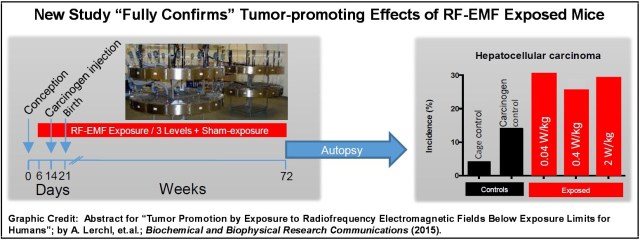Recente nieuwsberichten
Studie bevestigt kankerbevorderend effect
- Gegevens
- Geschreven: zaterdag 07 maart 2015 12:21

Sciencedirect.com - Een nieuwe studie wijst opnieuw op het kankerbevorderende effect van radiofrequente elektromagnetische straling, zelfs bij lage tot gematigde blootstellingsniveaus (SAR-waarde van 0.04 en 0.4 W/kg). De straling blijkt de werking van andere kankerverwekkende stoffen te versterken. Men vond onder meer tumoren op de longen, lever en lymfoma's.
Het gaat om een replicatie-onderzoek: het bevestigt de resultaten van eerder onderzoek, hetgeen wijst op een robuust en duidelijk effect.
De onderzoekers menen dat het tumorbevorderende effect te wijten is aan metabolische veranderingen door de stralingsblootstelling.
----------
Tumor promotion by exposure to radiofrequency electromagnetic fields below exposure limits for humans
Biochemical and Biophysical Research Communications
Available online 6 March 2015
Prof. Dr. Alexander Lerchl
Highlights
•Tumor-promoting effects of RF-EMF exposed mice have been reported in 2010.
•We have replicated the study with higher numbers of mice per group.
•We could fully confirm the previous results, thus the effects are reproducible.
•Apparently, no clear dose-response relationship is evident.
•We hypothesize that metabolic changes are responsible for the effects observed.
-
Abstract
"Previously published results from a pilot study with carcinogen-treated mice, however, suggested tumor-promoting effects of RF-EMF (Tillmann et al., 2010). We have performed a replication study using higher numbers of animals per group and including two additional exposure levels (0 (sham), 0.04, 0.4 and 2 W/kg SAR). We could confirm and extend the originally reported findings. Numbers of tumors of the lungs and livers in exposed animals were significantly higher than in sham-exposed controls. In addition, lymphomas were also found to be significantly elevated by exposure. A clear dose-response effect is absent. We hypothesize that these tumor-promoting effects may be caused by metabolic changes due to exposure. Since many of the tumor-promoting effects in our study were seen at low to moderate exposure levels (0.04 and 0.4 W/kg SAR), thus well below exposure limits for the users of mobile phones, further studies are warranted to investigate the underlying mechanisms. Our findings may help to understand the repeatedly reported increased incidences of brain tumors in heavy users of mobile phones."

